Dr.Teruo Higa’s
Living A Dream
- 2025
- Apr:#204 How EM Use Has Spread Throughout the Philippines
- Mar:#203 How to Use EM to Fundamentally Solve the Problem of Agricultural Residue Burning
- Feb:#202 The Spread of EM technology in Germany
- Jan:#201 The 2nd Ichiro Masaki Memorial Universal Village EM International Conference
- Jan:#200 Cleanup of the Ala Wai Canal in Hawaii, where social bonds are strengthened using EM
- 2024
- Nov:#199 EM trials in India with bananas, tomatoes, and pomegranates
- Oct:#198 The Steadily Evolving EM Nature Farming Method at the Blue Sky Palace - Part 8
- Sep:#197 The Steadily Evolving EM Nature Farming Method at the Blue Sky Palace - Part 7
- Aug:#196 The Steadily Evolving EM Nature Farming Method at the Blue Sky Palace - Part 6
- Jul:#195 The Steadily Evolving EM Nature Farming Method at the Blue Sky Palace - Part 5
- Jun:#194 Steadily Evolving EM Nature Farming Method at the Blue Sky Palace - Part 4
- May:#193 Steadily Evolving EM Nature Farming Method at the Blue Sky Palace - Part 3
- May:#192 Steadily Evolving EM Nature Farming Method at the Blue Sky Palace - Part 2
- Apr:#191 Steadily Evolving EM Nature Farming Method at the Blue Sky Palace
- Mar:#190 Quantum Mechanical Effects of EM Gravitron Charcoal
- Mar:#189 The barrier space in Okinawa (Ryukyu Islands) has risen to another dimension
- Jan:#188 Sixty Days after Typhoon No.6
- 2023
- Oct:#187 Supermassive Typhoon No.6 and Subsequent Typhoon No. 11
- Sep:#186 Massive Typhoon No.6 that swallowed the Ryukyu Islands Graviton barrier
- Sep:#185 August 8th is World “EM Mudball Day”
- Aug:#184 A disease-free life depends on the health of the intestinal microbiome.
- Jul:#183 Trial and Error at the Blue-Sky Palace, Part 3
- Jun:#182 Trial and Error at the Blue-Sky Palace, Part 2
- Apr:#181 Trial and Error at the Blue-Sky Palace
- Mar:#180 Ala Wai Canal Cleanup Project in Waikiki, Hawaii
- Feb:#179 High-Yield, High-Quality Rice Production Using EM
- Feb:#178 The Progress the "Soil Preparation Workshop" of the Oishi 3-chan Club (Part 2)
- Jan:#177 Organic Farming Instructional Manual Using EM
- 2022
- Nov:#176 The Typhoon Situation in Okinawa in 2022
- Sep:#175 Third-Party Verification of the Graviton barrier in Okinawa Part-2
- Sep:#174 Third-Party Verification of the Graviton barrier in Okinawa
- Aug:#173 Ecosystem Changes Observed in Okinawa in 2021 Part-5
- Jun:#172 Ecosystem Changes Observed in Okinawa in 2021 Part-4
- May:#171 Ecosystem Changes Observed in Okinawa in 2021 Part-3
- Apr:#170 Ecosystem Changes Observed in Okinawa in 2021 Part-2
- Mar:#169 Koizumi Farm in Kamakura Continues to Evolve
- Feb:#168 Ecosystem Changes Observed in Okinawa in 2021 Part-1
- 2021
- Dec:#167 Enjoying EM Technology While Enriching the Local Ecosystem
- Nov:#166 A Case Study of the Use of EM in a Next Generation Free School in Tune with the Cycles of Nature
- Oct:#165 Typhoon conditions and flowers in Okinawa from August to October
- Sep:#164 Re-learning the origins of river purification using EM Cleaning up the Dairyuji River in Senami (Murakami City, Niigata Prefecture)
- Aug:#163 Measures Against Natural Disasters and Re-learning the Starting Point of EM
- Jul:#162 Summary of FFC (Foods for Children) Okinawa Forum 2021
- Jun:#161 Restoring the Vigor of an Old Tree and Purifying the Environment with EM Technology That Even an Amateur Can Do
- May:#160 The Public is Beginning to Recognize the Use of EM Smokeless Carbonizers
- Apr:#159 EM Hado (EM Graviton) that exerts quantum superposition effect over time
- Mar:#158 Virus-free Okinawan Plants Through Use of an EM Graviton Barrier
- Jan:#157 Enjoyable Farming for Self-Sufficiency that Even Amateurs Can Do
- 2020
- Dec:#156 EM quantum energy effect occurring in Okinawa
- Nov:#155 Implementing EM graviton farming as a flood countermeasure for apple orchards
- Oct:#154 The Latest Book on the Practical Uses of EM "You Are the One Who Draws Out the Power of Microorganisms," by Chizuko Nomoto
- Sep:#153 Application of EM technology to long periods of rain, lack of sunshine, storms, heavy rains, etc.
- Aug:#152 EM application in Kitanakagusuku village plant waste recycling yard
- Jul:#151 Natural Disaster Countermeasures Using EM Technology: Part 2
- Jul:#150 Natural Disaster Countermeasures Using EM Technology
- May:#149 How to make your home and workplace an energy spot by living a complete EM lifestyle: creating the ultimate source of health and environmental purification
- Apr:#148 EM, Viruses and the Pandemic
- Apr:#147 New agriculture applying quantum mechanics Part 2
- Apr:#146 New agriculture applying quantum mechanics
- Apr:#145 Wonderful EM Miracle
- 2019
- Nov:#144 The movie “Revival II” and the reality of Fukushima
- Oct:#143 Boundary dome and foliar spraying of EM・X GOLD and EM 3
- Oct:#142 Kirakira (Sparkling) Summer Vegetable Festa in 2019
- Aug:#141 Excessive salt inevitably causes salt damage
- Jul:#140 Diverse applications of charcoal Part 3
- Jun:#139 Diverse applications of charcoal Part 2
- Jun:#138 Diverse applications of charcoal
- Jun:#137 Purification power of salt
- May:#136 The degree of soil contamination is a reflection of the microflora
- May:#135 Definitive use of EM barriers to deal with typhoons
- May:#134 Implementing authentic Nature Farming
- May:#133 How to enhance healthy Hado (wave energy) by EM
- May:#132 Eating Dirt (Soil)
- May:#131 Hado (Wave energy) involved in health
- May:#130 Reaffirming EM technology to realize the essence of agriculture
- May:#129 The 2nd EM Producer Networking Meeting
- Apr:#128 Understanding the application of seawater and salt in crop cultivation
- Apr:#127 Prevention of Disasters by EM Technology
- Mar:#126 Quantum overlay effective utilization of EM
- Jan:#125 EM Disaster Recovery Support Projects in 2017
- 2018
- 2017
- Aug:#121 Escape from conventional agricultural traps
- Jul:#120 Limitation and important caveats regarding utilization of salt
- Jun:#119 EM Technology to Break Through the Limits of Pesticide-Free Strawberries
- May:#118 Application of barriers using EM rectification force
- Apr:#117 The 1st EM Produce Growers' Networking Conference
- Mar:#116 Sumizo kun: The Ultimate Versatile Carbonization Equipment
- Feb:#115 How to make and use simple carbonized and rectified ash
- Jan:#114 Achievements of 2016
- 2016
- Dec:#113 Definitive Measures Against Typhoons
- Nov:#112 International Conference on Universal Village
- Oct:#111 90% of Your Body is Microbes
- Sep:#110 Disaster Countermeasures Using EM
- Aug:#109: Changes in the Natural Environment by EM Barrier Domes in Okinawa
- Jul:#108: Multi-purpose Utilization of Activated EM with Seawater and Salt
- Jun:#107: Marine Day, when EM Mudballs and Activated EM are Applied Throughout Japan
- May:#106: The Function of EM and Gravitational Waves–Part 3
- Apr:#105: The Function of EM and Gravitational Waves–Part 2
- Feb:#104: The Function of EM and Gravitational Waves
- Feb:#103: The Importance of Phototrophic Bacteria in EM
- 2015
- Dec:#102: Results of Environmental Forum "Utsukushima EM Paradise" 2015
- Nov:#101: Environmental Forum "Utsukushima EM Paradise" 2015
- Oct:#100: A New Phase of Limit Breakthrough Using EM
- Sep:#99: A New Phase of Limit Breakthrough through EM
- Aug:#98: The Tokyo Bay Area Began Creating a Truly Livable Hometown
- Jul:#97: Rectifying Effects of EM
- Jun:#96: Lake Suwa Sousei lecture
- May:#95: In Order to Further Ensure Limit Breakthrough
- Apr:#94: Theatrical Release of the Documentary Film SOSEI-Revival to Enlighten People on the New Possibilities of Microorganisms
- Mar:#93: What Underlies Limit Breakthrough (Part 2)
- Feb:#92: EM Functions to Break Through Limits
- Jan:#91: At the Start of 2015
- 2014
- Dec:#90: Looking Back at 2014
- Nov:#89: Shikoku EM FESTA 2014, Virtuous Circle Conference in Matsuyama, Ehime Prefecture
- Oct:#88: Using EM to Deal with Weather Disasters (Part 2)
- Sep:#87: Current Status of Radioactivity Measures Using EM in Fukushima
- Aug:#86: APNAN (Asia Pacific Natural Agriculture Network) 25th Anniversary Conference in 2014
- Jul:#85: Using EM to Deal with Weather Disasters
- Jun:#84: Substantial Improvement of Soil
- May:#83: The Energy Rectification Force of EM
- Apr:#82: The Annual 18th EM Technology Exchange Meeting and Tohoku Conference in Shichigahama
- Mar:#81: Salmon going upstream in Kitaura (Kasumigaura)
- Feb:#80: The Microbiome Again
- Jan:#79: Inauguration of the Federation of Diet Members Who Use and Apply Effective Microorganisms
- 2013
- Dec:#78: Receiving an Honorary Doctoral Degree from Rajamangala University of Technology in Thailand
- Nov:#77: The Use of EM in School Education in Bhutan
- Oct:#76: Well of Bonding
- Sep:#75: The Background to EM Not Being Employed by Public Institutions to Deal with Radiation
- Aug:#74: Dealing with Disaster: Using EM in Crisis Management
- Jul:#73: EM Events on Ocean Day
- Jun:#72: Using EM to Deal With Heat Stroke and Summer Heat Fatigue
- May:#71: An EM Model Town in Malaysia
- Apr:#70: Steps the Japanese Government is Taking to Deal with Radiation: Are They Really Safe?
- Mar:#69: EM Group Disaster Reconstruction Aid Project in Fukushima
- Feb:#68: EM and Microbiomes (Microbial Flora)
- Jan:#67: A Necessary Evil is Still Evil
- 2012
- Dec:#66: The 17th National EM Technology Exchange Conference / Hokkaido Conference in Sapporo
- Nov:#65: EM Forum 2012 in Okinawa and the Environmental Forum in Fukushima
- Oct:#64: 2012 EM Forum
- Sep:#63: A New Earth Saving Revolution
- Aug:#62: The Asahi Newspaper’s Misguided Reports About EM
- Jul:#61: Using EM in Radioactive Contamination Measures in Fukushima Prefecture
- Jun:#60: The Effects of Using EM to Inhibit the Absorption of Radioactivity as Confirmed in Fukushima
- May:#59: Recovery Support for the Great East Japan Earthquake
- Apr:#58: The Royal Kingdom of Thailand, in which EM Functions as a Set Government Policy
- Mar:#57: Report on the Measures Taken by Kingdom of Thailand Using EM to Deal with Polluted Water
- Feb:#56 EM™ as Part of National Policy in Thailand to Deal with Sanitation Issues Resulting from the Flood of 2011
- Jan:#55 The Law of Syntropy (Revitalization)
- 2011
- Dec:#54 EM Forum 2011
- Nov:#53 Shikoku EM Festa 2011- Zenjunkan no Wa (Virtuous Circle) Tokushima Conference in Naruto -
- Oct:#52 The Mystery of Interim Safety Values for Radioactive Material
- Sep:#51 Successful Radiation Countermeasures Using EM
- Aug:#50 Events on Sea Day in which EM Mud Balls are Thrown into the Water and Activated EM is Applied.
- May:#47 Dealing with the Damage Caused by the Eastern Japan Earthquake
- Apr:#46 Eastern Japan Earthquake
- Mar:#45 The 16th National EM Technology Hokuriku Conference in Fukui
- Feb:#44 More Thoughts on Avian Influenza and Foot-and-Mouth Disease
- Jan:#43 Happy New Year!
- 2010
- Dec:#42 Shikoku EM FESTA 2010・Zenjunkan no wa (Virtuous Circle) Fellowship Conference in Tobe, Ehime Prefecture
- Nov:#41 EM Forum 2010
- Oct:#40: My Thanks to the EM™ Volunteers Who Helped in the Fight Against Foot-and-Mouth Disease in Miyazaki Prefecture
- Sep:#39 International EM Mud Ball Day
- Jul:#37 Poland EM Forum 2010
- Jun:#36 EM Countermeasures Against Foot-and-Mouth Disease
- May:#35 Abnormal Weather
- Apr:#34 EM Activities in Thailand: Finding Solutions to the Challenges Facing the Nation
- Mar:#33 New Developments in the Evolution of EMTM in Thailand
- Feb:#32 Results Starting to Be Seen at the Mikasa Project
- Jan:#31 Towards an EM-Use Society
- 2009
- Dec:#30 EM Summit
- Nov:#29 The System in Penang State in Malaysia that Made the World EMTM Mudball Day a Success
- Oct:#28 The "World EM Mudball Day" in Malaysia
- Sep:#27 Validating EMTM Medicine: Case Study Reports from EM Users 2009. (Part 3)
- Sep:#26 Validating EMTM Medicine: Case Study Reports from EMTM Users 2009. (Part 2)
- Jul:#25 Validating EMTM Medicine: Case Study Reports from EMTM Users 2009. (Part 1)
- Jun:#24 Activities to Disseminate EM-Focused Nature Farming in China
- May:#23 Use of EMTM in Response to Swine Flu
- Apr:#22 Using EM to Solve Public Administrative Costs
- Mar:#21 Reaffirming the Versatility of EM
- Jan:#20 The Beginning of a New Era
- 2008
#168 Ecosystem Changes Observed in Okinawa in 2021 Part-1
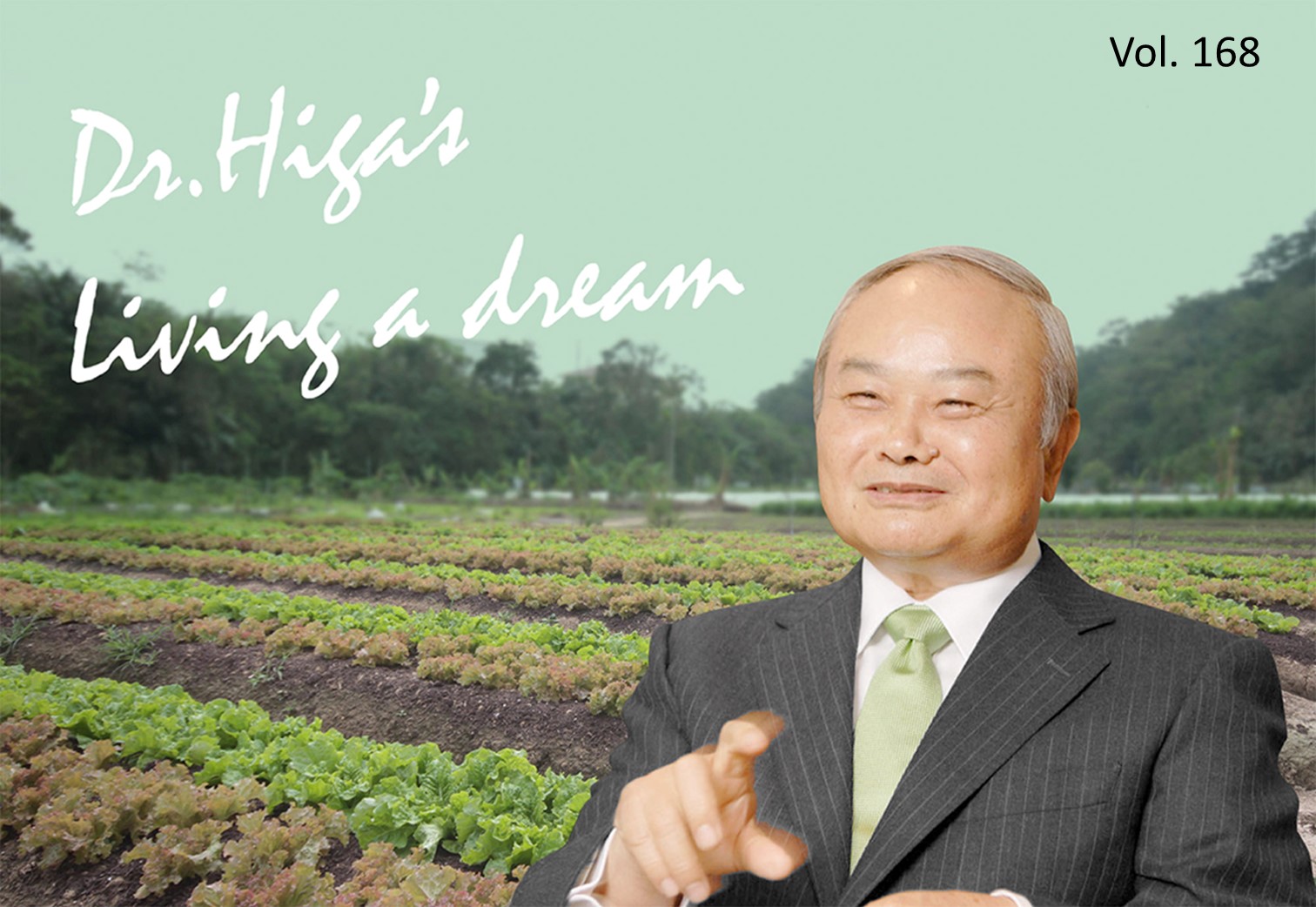
In article 165, I discussed how the weather and agricultural environment in Okinawa in 2021 have become more favorable and stable. Positive effects of these changes are gradually becoming evident in natural ecosystems.
This time, I move from the field of agriculture to news about the great increase in the number of migratory birds in the Ryukyu Islands. Compared to past years, this last year has seen has a significant increase in information on migratory birds published in the local newspapers. After the creation of the Gravitron Barrier in 2013, I noticed an increase in news about migratory birds and I intentionally started clipping out these articles.
In the past few years, it has become evident that the number of birds coming to Okinawa has increased yearly and below I give some examples of these occurrences in 2021. The photos are mainly from Ishigaki Island, but a variety of migratory birds have been observed on the main island of Okinawa, as well even on Miyako Island and Daito Island.
-------------------------------
This time, I move from the field of agriculture to news about the great increase in the number of migratory birds in the Ryukyu Islands. Compared to past years, this last year has seen has a significant increase in information on migratory birds published in the local newspapers. After the creation of the Gravitron Barrier in 2013, I noticed an increase in news about migratory birds and I intentionally started clipping out these articles.
In the past few years, it has become evident that the number of birds coming to Okinawa has increased yearly and below I give some examples of these occurrences in 2021. The photos are mainly from Ishigaki Island, but a variety of migratory birds have been observed on the main island of Okinawa, as well even on Miyako Island and Daito Island.
-------------------------------
Rare birds one after another arrive in Ishigaki Island
Photo by Mr. Kobayashi, field guide November 15, 2021 (Courtesy of Okinawa Times)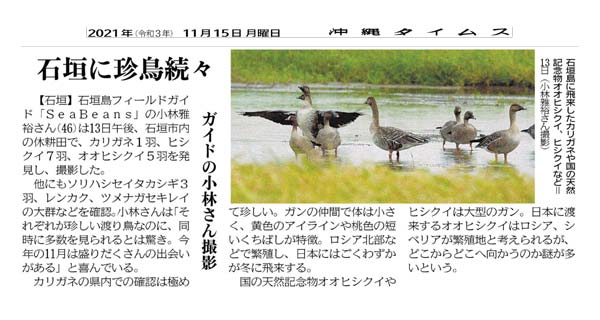
・The lesser white-fronted goose that came to Ishigaki Island and the national natural treasure, bean goose and great bean goose, taken on the 13th. (Photo by Masahiro Kobayashi)
On the afternoon of the 13th, Mr. Masahiro Kobayashi, 46, of the Ishigaki Island field guide shop “SeaBeans,” found and photographed one lesser white-fronted goose, seven bean gooses, and five great bean gooses in a fallow rice field in Ishigaki City.
He also saw three pied avocet and a large group of pheasant-tailed jacana and yellow wagtail.
Mr. Kobayashi said, “Each of these is a rare migratory bird, and I was surprised to see so many of them at the same time. I expect many encounters in November of this year,” he said happily.
It is extremely rare to see a lesser white-fronted goose in Okinawa Prefecture. It is a small species of goose family with a yellow eyeline and a short pink beak. They breed in northern Russia and other parts of the world, and only a few fly to Japan in winter. The great bean gooses and the bean gooses, both national natural treasures, are large geese. The great bean gooses that fly to Japan is believed to breed in Russia and Siberia, but it is unclear where it comes from and where it goes thereafter.
-------------------------------
Wild birds appear one after another in Ishigaki Island
Rosy Starling (young and adult), Black-winged cuckooshrike and Eurasian hoopoe
Photo by Mr. Kobayashi. Gathering during the migratory season December 11, 2021 (Courtesy of Okinawa Times)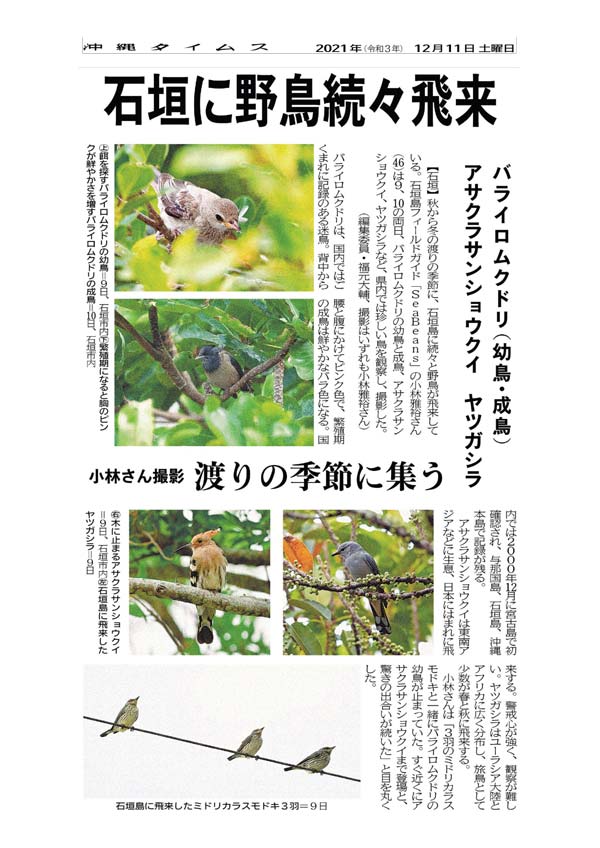
・Photo above: A young Rosy starling looking for food in Ishigaki City on the 9th
・Photo below: An adult Rosy starling whose pink chest becomes more vivid during the breeding season, in Ishigaki City on October 10th
・Right photo: A black-winged cuckoo perching on a tree, 9th, Ishigaki City
・Left photo: Eurasian hoopoes flying to Ishigaki Island, 9th
・Three Asian glossy starlings flew to Ishigaki Island on the 9th
Wild birds are flying to Ishigaki Island one after another during the migration season, which runs from autumn to winter. Mr. Masahiro Kobayashi, 46, of the Ishigaki Island field guide shop “SeaBeans,” observed and photographed rare birds in the prefecture, such as young and adult Rosy starlings, black-winged cuckoos, and Eurasian hoopoes on both the 9th and 10th. (Daisuke Fukumoto, editor; all photos by Masahiro Kobayashi)
The rosy starling is a migratory bird that has been rarely sighted in Japan. It is pink from the back to the waist and belly, and adult birds turn a bright rose color during breeding season. In Japan, it was first sighted on Miyako Island in December 2000, and there are records of sightings on Yonaguni Island, Ishigaki Island, and the main island of Okinawa.
The Black-winged cuckoo is found in Southeast Asia and other parts of the world, though they rarely come to Japan. They are very cautious and difficult to observe. The Hoopoes are widely distributed in the Eurasia Continent and Africa, and a small number of them fly to Japan in spring and autumn as migratory birds. Mr. Kobayashi noted that, “A young Rosy starling was perched along with three Asian glossy starlings. There was even a Black-winged cuckoo nearby, so I had a series of surprising encounters.”
-------------------------------
25 white-fronted geese fly to Ishigaki Island
November 9, 2021 (Courtesy of Okinawa Times)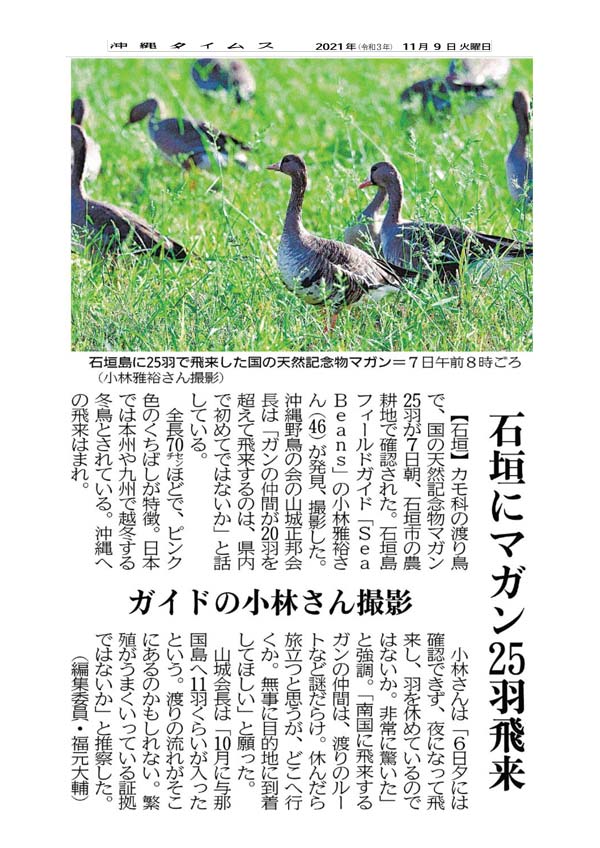
・A flock of 25 white-fronted geese, a national natural treasure, flew into Ishigaki Island at around 8 am on July 7th. (photo by Masahiro Kobayashi)
A national natural treasure, twenty-five white-fronted geese, a migratory bird of the duck family, were sighted in farmland in Ishigaki City on the morning of the 7th. Mr. Masahiro Kobayashi, 46, of the Ishigaki Island field guide shop “SeaBeans,” found and photographed them. Mr. Masakuni Yamashiro, chairman of the Okinawa Wild Bird Society, said, “I believe this is the first time in Okinawa Prefecture that more than twenty geese have flown to the area.” The bird is about 70 centimeters in length with a distinctive pink beak. In Japan, it is considered a winter bird that spends winters in Honshu and Kyushu. It rarely appears in Okinawa.
“I couldn’t confirm this on the evening of the 6th,” Mr. Kobayashi said. “I think they flew in at night and were resting their wings. I was very surprised to see them.” He added, “There are many mysteries surrounding the migratory route of geese that fly to tropical countries. I am sure they will leave after they rest, but where will they go next? I hope that they arrive safely at their destination.” Chairman Yamashiro speculated, “I heard that about eleven geese arrived in Yonaguni Island in October. That might be part of a migratory route and may be evidence that breeding is proceeding well.” (Daisuke Fukumoto, Editor)
-------------------------------
Migratory bird in Ishigaki Island
First sighting of a Common Snipe December 3, 2021 (Courtesy of Okinawa Times)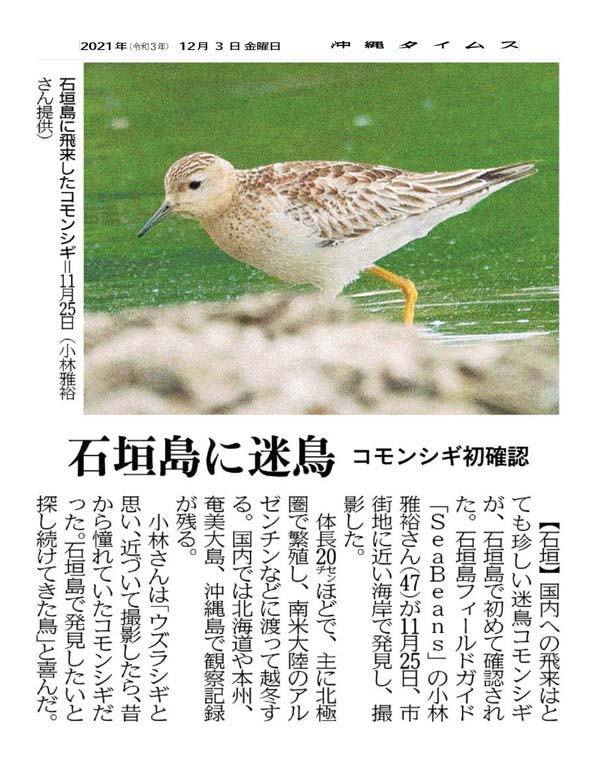
・The common snipe that flew to Ishigaki Island on November 25th (Courtesy of Masahiro Kobayashi)
The migratory common snipe, which very rarely flies to Japan, was sighted for the first time on Ishigaki Island in Okinawa. Mr. Masahiro Kobayashi, 47, of the Ishigaki Island field guide shop “SeaBeans,” found and photographed the bird at a beach near the city center on November 25th. This variety of bird is about 20 centimeters in length and breeds mainly in the Arctic Circle before migrating to Argentina and other parts of South America for the winter. In Japan, there are recorded sightings in Hokkaido, Honshu, Amami Oshima and Okinawa Island.
“At first I thought it was a quail sandpiper,” Mr. Kobayashi said happily, “but when I got closer to photograph it, it turned out to be a common sandpiper, which I have longing to sight. It’s a bird I have been searching for, hoping to discover it on Ishigaki Island.”
-------------------------------
Rare bird resting in millet fields in Ishigaki Island
The arrival of a tree pipit December 1, 2021 (Courtesy of Okinawa Times)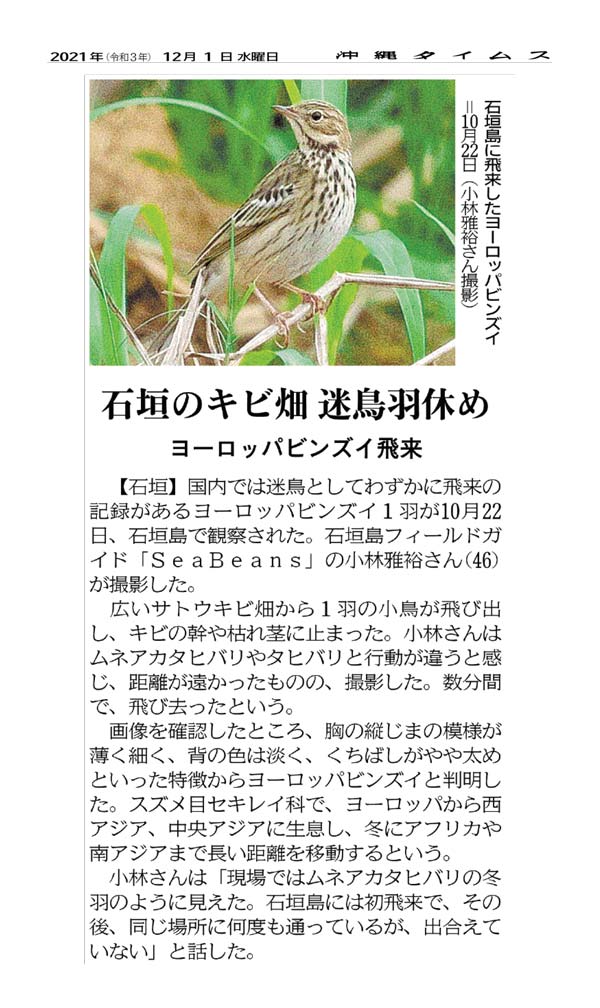
・The tree pipit that flew to Ishigaki Island on October 22nd (Courtesy of Masahiro Kobayashi)
On October 22, a single migratory tree pipit, which has rarely been sighted in Japan, was observed on Ishigaki Island in Okinawa Prefecture. Mr. Masahiro Kobayashi, 46, of the Ishigaki Island field guide shop “SeaBeans,” found and photographed the bird. A small bird flew out from a large sugar cane field and perched on the trunk and dead stalks of the millet. Mr. Kobayashi felt that its behavior was different from that of a red-throated pipit, so he photographed it even though it was far away. After a few minutes, he said, it flew away.
After checking the images, the bird was determined to be a tree pipit because it had that bird’s characteristics: a thin, pale pattern of vertical stripes on its chest, pale coloring on its back, and a slightly thicker beak. It is a member of the sparrow family (Passerine Motacillidae) and inhabits Europe, Western Asia and Central Asia, and migrates long distances to Africa and South Asia in winter. Mr. Kobayashi said, “At the site, it looked like it had the winter feathers of a Red-throated Pipit. It was the first time it flew to Ishigaki Island, and I have been to the same place many times since then, but I have not been able to find it again.”
-------------------------------
Very rare bird arrives in Ishigaki Island
Ruddy shelduck resting its wings December 7, 2021 (Courtesy of Okinawa Times)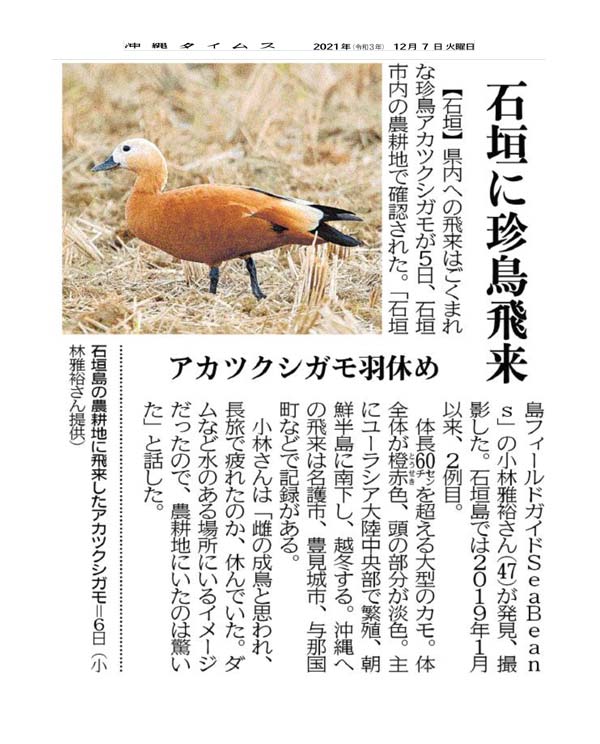
・The Ruddy shelduck that flew to Ishigaki Island on December 6th (Courtesy of Masahiro Kobayashi)
A very rare bird, the Ruddy shelduck, which rarely flies to Okinawa Prefecture, was sighted in farmland in Ishigaki City on the 5th. Mr. Masahiro Kobayashi, 47, of the Ishigaki Island field guide shop “SeaBeans,” found and photographed it. This is the second case in Ishigaki Island since January 2019. It is a large duck, over 60 centimeters long. Its entire body is orange-red, and the head is light-colored. It breeds mainly in central Eurasia. It migrates south to the Korean Peninsula and spends winters there. There are records of them flying to Okinawa in Nago City, Tomigusuku City or Yonaguni Town. Mr. Kobayashi said, “It seemed to be an adult female bird, and was resting, probably tired from its long journey. It surprised me to discover it in farmland because I had a mental image of it being in a place such as a dam.”
-------------------------------
Two rare birds fly to Ishigaki Island one after the other
There are almost no sightings in Okinawa PrefecturePhotographed by Mr. Kobayashi October 17, 2021 (Courtesy of Okinawa Times)

・A yellow-breasted bunting that arrived on Ishigaki Island, Okinawa Prefecture on the 3rd (photo by Masahiro Kobayashi)
・A reed bunting that arrived on Ishigaki Island on the 6th (photo by Masahiro Kobayashi)
On the 3rd, Mr. Masahiro Kobayashi, 46, of the Ishigaki Island field guide shop “SeaBeans,” took pictures of a yellow-breasted bunting on Ishigaki Island, Okinawa Prefecture, and a reed bunting on the 6th. Both are members of the white-throated bunting family and are about the size of a sparrow. They are rarely observed in Okinawa Prefecture and are considered rare birds.
This is the second record of yellow-breasted bunting on Ishigaki Island since December 2009.
The belly of the bird is yellow, the belly of females not as bright as that of males, and it was determined that the individual bird that flew in was a female. Mr. Kobayashi was pleased, saying, “I saw an unfamiliar little bird on an ear of rice, so I checked it with binoculars and hurriedly snapped a photo.”
The reed bunting was with a flock of yellow Wagtails. “It was picking at grass seeds,” Mr. Kobayashi noted, “but flew away immediately. Records are unclear of sightings of this bird in the past, but I think this is the first-ever sighting in Ishigaki Island.”
-------------------------------
Two migratory birds fly into Ishigaki Island
November 19, 2021 (Courtesy of Okinawa Times)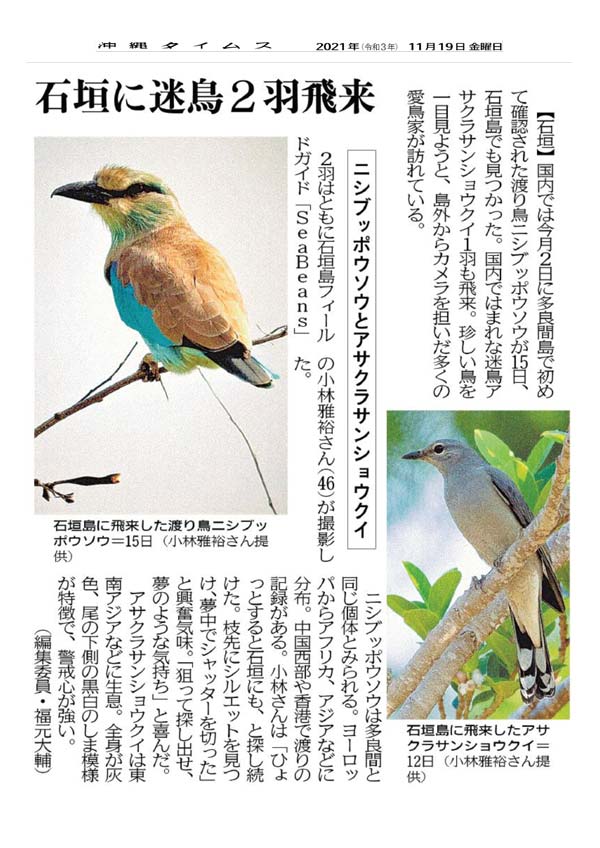
・The migratory bird, the European Roller, that flew to Ishigaki Island on November 15th (Courtesy of Mr. Masahiro Kobayashi)
・The black-winged Cuckooshrike that flew to Ishigaki Island on November 12th (Courtesy of Mr. Masahiro Kobayashi)
On the 15th, a migratory bird, a European Roller, which was first seen in Japan on Tarama Island in Okinawa Prefecture on the 2nd of this month, was also found on Ishigaki Island. Another migratory bird, the black-winged Cuckooshrike , also flew to Ishigaki Island. Many bird lovers from outside the island came with their cameras to catch a glimpse of the very rare bird. Many bird lovers from outside the island came with their cameras to catch a glimpse of these rare birds.
European Roller and Black-winged Cuckooshrike
The two birds were both photographed by Mr. Masahiro Kobayashi (46) of the Ishigaki Island field guide shop “SeaBeans.” The European roller is believed to be the same bird as the one seen in Tarama Island. It is distributed from Europe to Africa and Asia, and there are records of its migration in western China and Hong Kong. Mr. Kobayashi said, excitedly, “I kept looking for them, hoping to find some in Ishigaki Island. When I spotted a silhouette on the tip of a branch and, amazed, snapped a photo, it was like a dream come true.”
Black-winged Cuckooshrike inhabit Southeast Asia and other parts of the world. It is characterized by a gray body and black-and-white striped pattern on the underside of its tail, and is known as very cautious. (Daisuke Fukumoto, editor)
-------------------------------
The arrival of White-naped Cranes
First confirmed sighting in Minamidaito Island
“A large, elegant-looking bird” November 29, 2021 (Courtesy of Okinawa Times)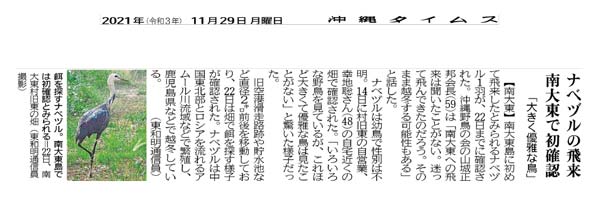
・The White-naped crane searching for food, apparently the first confirmed sighting on Minamidaito Island.
・On the 22nd, in a field in Kyuto, Minami Daito Village (Photo by Kazuaki Higashi, reporter)
A White-naped crane, which seems to have arrived on Minamidaito Island for the first time, was confirmed by the 22nd. Mr. Masakuni Yamashiro (59), chairman of the Okinawa Wild Bird Society, said, “I have never heard of this bird flying to Minamidaito. It must have flown here because it was lost. There is a possibility that it will continue to winter here.”
The White-naped crane is a young bird and its gender is unknown. It was confirmed on the 14th in a field near the home of Mr. Satoshi Kochi (48), an independent business owner in Kyuto village. He seemed surprised, saying, “I’ve seen a lot of wild birds, but I’ve never seen such a large and elegant-looking bird.”
It was spotted moving in an area two kilometers in diameter around the runway of the old airport and the reservoir and on the 22nd was observed searching for food in the fields. The White-naped crane breeds in the Amur River basin, which flows through northeastern China and Russia, and winters in Kagoshima prefecture and other areas. (Kazuaki Higashi, reporter)
-------------------------------
Black-faced Spoonbills prepare for winter Three birds in Kunigami Village
November 20, 2021 (Courtesy of Okinawa Times)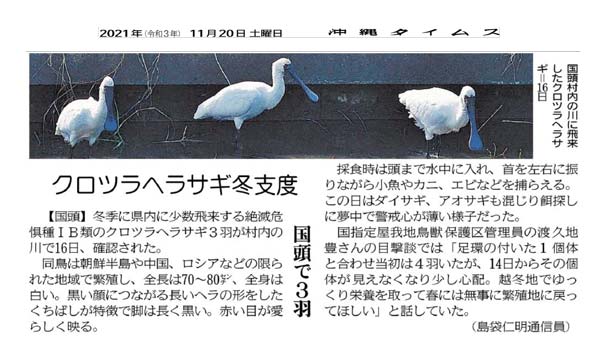
・Black-faced Spoonbill arrives at a river in Kunigami Village on the 16th.
On the 16th, three Black-faced Spoonbills, an endangered IB species that flies to Okinawa prefecture in small numbers during the winter, were sighted in a river in the village. The birds breed in limited areas in the Korean Peninsula, China and Russia, and are 70-80 centimeters in length with a white body. They have a black face with a long spatula-shaped beak and long black legs, as well as lovely red eyes.
When they forage, they put their heads underwater and shake their heads from side to side while catching small fish, crabs, shrimp, etc. On the day of our visit, Great egrets and Grey herons were also present, all so absorbed in the search for food that they were less cautious.
According to Mr. Yutaka Toguchi, manager of the nationally designated wild bird and wildlife sanctuary, “There were four birds at first, including one with an ankle ring, but I am a little worried because I have not seen that one particular bird since the 14th. My hope is that they take their time to nourish themselves where they spend the winter and then return safely in the spring to their breeding grounds.
(Reported by Hitoaki Shimabukuro)
(January 24, 2022)
Editor’s Picks
-

#196 The Steadily Evolving EM Nature Farming Method at the Blue Sky Palace - Part 6 -

#195 The Steadily Evolving EM Nature Farming Method at the Blue Sky Palace - Part 5 -

#191 Steadily Evolving EM Nature Farming Method at the Blue Sky Palace -

#190 Quantum Mechanical Effects of EM Gravitron Charcoal
- 2025
- Apr:#204 How EM Use Has Spread Throughout the Philippines
- Mar:#203 How to Use EM to Fundamentally Solve the Problem of Agricultural Residue Burning
- Feb:#202 The Spread of EM technology in Germany
- Jan:#201 The 2nd Ichiro Masaki Memorial Universal Village EM International Conference
- Jan:#200 Cleanup of the Ala Wai Canal in Hawaii, where social bonds are strengthened using EM
- 2024
- Nov:#199 EM trials in India with bananas, tomatoes, and pomegranates
- Oct:#198 The Steadily Evolving EM Nature Farming Method at the Blue Sky Palace - Part 8
- Sep:#197 The Steadily Evolving EM Nature Farming Method at the Blue Sky Palace - Part 7
- Aug:#196 The Steadily Evolving EM Nature Farming Method at the Blue Sky Palace - Part 6
- Jul:#195 The Steadily Evolving EM Nature Farming Method at the Blue Sky Palace - Part 5
- Jun:#194 Steadily Evolving EM Nature Farming Method at the Blue Sky Palace - Part 4
- May:#193 Steadily Evolving EM Nature Farming Method at the Blue Sky Palace - Part 3
- May:#192 Steadily Evolving EM Nature Farming Method at the Blue Sky Palace - Part 2
- Apr:#191 Steadily Evolving EM Nature Farming Method at the Blue Sky Palace
- Mar:#190 Quantum Mechanical Effects of EM Gravitron Charcoal
- Mar:#189 The barrier space in Okinawa (Ryukyu Islands) has risen to another dimension
- Jan:#188 Sixty Days after Typhoon No.6
- 2023
- Oct:#187 Supermassive Typhoon No.6 and Subsequent Typhoon No. 11
- Sep:#186 Massive Typhoon No.6 that swallowed the Ryukyu Islands Graviton barrier
- Sep:#185 August 8th is World “EM Mudball Day”
- Aug:#184 A disease-free life depends on the health of the intestinal microbiome.
- Jul:#183 Trial and Error at the Blue-Sky Palace, Part 3
- Jun:#182 Trial and Error at the Blue-Sky Palace, Part 2
- Apr:#181 Trial and Error at the Blue-Sky Palace
- Mar:#180 Ala Wai Canal Cleanup Project in Waikiki, Hawaii
- Feb:#179 High-Yield, High-Quality Rice Production Using EM
- Feb:#178 The Progress the "Soil Preparation Workshop" of the Oishi 3-chan Club (Part 2)
- Jan:#177 Organic Farming Instructional Manual Using EM
- 2022
- Nov:#176 The Typhoon Situation in Okinawa in 2022
- Sep:#175 Third-Party Verification of the Graviton barrier in Okinawa Part-2
- Sep:#174 Third-Party Verification of the Graviton barrier in Okinawa
- Aug:#173 Ecosystem Changes Observed in Okinawa in 2021 Part-5
- Jun:#172 Ecosystem Changes Observed in Okinawa in 2021 Part-4
- May:#171 Ecosystem Changes Observed in Okinawa in 2021 Part-3
- Apr:#170 Ecosystem Changes Observed in Okinawa in 2021 Part-2
- Mar:#169 Koizumi Farm in Kamakura Continues to Evolve
- Feb:#168 Ecosystem Changes Observed in Okinawa in 2021 Part-1
- 2021
- Dec:#167 Enjoying EM Technology While Enriching the Local Ecosystem
- Nov:#166 A Case Study of the Use of EM in a Next Generation Free School in Tune with the Cycles of Nature
- Oct:#165 Typhoon conditions and flowers in Okinawa from August to October
- Sep:#164 Re-learning the origins of river purification using EM Cleaning up the Dairyuji River in Senami (Murakami City, Niigata Prefecture)
- Aug:#163 Measures Against Natural Disasters and Re-learning the Starting Point of EM
- Jul:#162 Summary of FFC (Foods for Children) Okinawa Forum 2021
- Jun:#161 Restoring the Vigor of an Old Tree and Purifying the Environment with EM Technology That Even an Amateur Can Do
- May:#160 The Public is Beginning to Recognize the Use of EM Smokeless Carbonizers
- Apr:#159 EM Hado (EM Graviton) that exerts quantum superposition effect over time
- Mar:#158 Virus-free Okinawan Plants Through Use of an EM Graviton Barrier
- Jan:#157 Enjoyable Farming for Self-Sufficiency that Even Amateurs Can Do
- 2020
- Dec:#156 EM quantum energy effect occurring in Okinawa
- Nov:#155 Implementing EM graviton farming as a flood countermeasure for apple orchards
- Oct:#154 The Latest Book on the Practical Uses of EM "You Are the One Who Draws Out the Power of Microorganisms," by Chizuko Nomoto
- Sep:#153 Application of EM technology to long periods of rain, lack of sunshine, storms, heavy rains, etc.
- Aug:#152 EM application in Kitanakagusuku village plant waste recycling yard
- Jul:#151 Natural Disaster Countermeasures Using EM Technology: Part 2
- Jul:#150 Natural Disaster Countermeasures Using EM Technology
- May:#149 How to make your home and workplace an energy spot by living a complete EM lifestyle: creating the ultimate source of health and environmental purification
- Apr:#148 EM, Viruses and the Pandemic
- Apr:#147 New agriculture applying quantum mechanics Part 2
- Apr:#146 New agriculture applying quantum mechanics
- Apr:#145 Wonderful EM Miracle
- 2019
- Nov:#144 The movie “Revival II” and the reality of Fukushima
- Oct:#143 Boundary dome and foliar spraying of EM・X GOLD and EM 3
- Oct:#142 Kirakira (Sparkling) Summer Vegetable Festa in 2019
- Aug:#141 Excessive salt inevitably causes salt damage
- Jul:#140 Diverse applications of charcoal Part 3
- Jun:#139 Diverse applications of charcoal Part 2
- Jun:#138 Diverse applications of charcoal
- Jun:#137 Purification power of salt
- May:#136 The degree of soil contamination is a reflection of the microflora
- May:#135 Definitive use of EM barriers to deal with typhoons
- May:#134 Implementing authentic Nature Farming
- May:#133 How to enhance healthy Hado (wave energy) by EM
- May:#132 Eating Dirt (Soil)
- May:#131 Hado (Wave energy) involved in health
- May:#130 Reaffirming EM technology to realize the essence of agriculture
- May:#129 The 2nd EM Producer Networking Meeting
- Apr:#128 Understanding the application of seawater and salt in crop cultivation
- Apr:#127 Prevention of Disasters by EM Technology
- Mar:#126 Quantum overlay effective utilization of EM
- Jan:#125 EM Disaster Recovery Support Projects in 2017
- 2018
- 2017
- Aug:#121 Escape from conventional agricultural traps
- Jul:#120 Limitation and important caveats regarding utilization of salt
- Jun:#119 EM Technology to Break Through the Limits of Pesticide-Free Strawberries
- May:#118 Application of barriers using EM rectification force
- Apr:#117 The 1st EM Produce Growers' Networking Conference
- Mar:#116 Sumizo kun: The Ultimate Versatile Carbonization Equipment
- Feb:#115 How to make and use simple carbonized and rectified ash
- Jan:#114 Achievements of 2016
- 2016
- Dec:#113 Definitive Measures Against Typhoons
- Nov:#112 International Conference on Universal Village
- Oct:#111 90% of Your Body is Microbes
- Sep:#110 Disaster Countermeasures Using EM
- Aug:#109: Changes in the Natural Environment by EM Barrier Domes in Okinawa
- Jul:#108: Multi-purpose Utilization of Activated EM with Seawater and Salt
- Jun:#107: Marine Day, when EM Mudballs and Activated EM are Applied Throughout Japan
- May:#106: The Function of EM and Gravitational Waves–Part 3
- Apr:#105: The Function of EM and Gravitational Waves–Part 2
- Feb:#104: The Function of EM and Gravitational Waves
- Feb:#103: The Importance of Phototrophic Bacteria in EM
- 2015
- Dec:#102: Results of Environmental Forum "Utsukushima EM Paradise" 2015
- Nov:#101: Environmental Forum "Utsukushima EM Paradise" 2015
- Oct:#100: A New Phase of Limit Breakthrough Using EM
- Sep:#99: A New Phase of Limit Breakthrough through EM
- Aug:#98: The Tokyo Bay Area Began Creating a Truly Livable Hometown
- Jul:#97: Rectifying Effects of EM
- Jun:#96: Lake Suwa Sousei lecture
- May:#95: In Order to Further Ensure Limit Breakthrough
- Apr:#94: Theatrical Release of the Documentary Film SOSEI-Revival to Enlighten People on the New Possibilities of Microorganisms
- Mar:#93: What Underlies Limit Breakthrough (Part 2)
- Feb:#92: EM Functions to Break Through Limits
- Jan:#91: At the Start of 2015
- 2014
- Dec:#90: Looking Back at 2014
- Nov:#89: Shikoku EM FESTA 2014, Virtuous Circle Conference in Matsuyama, Ehime Prefecture
- Oct:#88: Using EM to Deal with Weather Disasters (Part 2)
- Sep:#87: Current Status of Radioactivity Measures Using EM in Fukushima
- Aug:#86: APNAN (Asia Pacific Natural Agriculture Network) 25th Anniversary Conference in 2014
- Jul:#85: Using EM to Deal with Weather Disasters
- Jun:#84: Substantial Improvement of Soil
- May:#83: The Energy Rectification Force of EM
- Apr:#82: The Annual 18th EM Technology Exchange Meeting and Tohoku Conference in Shichigahama
- Mar:#81: Salmon going upstream in Kitaura (Kasumigaura)
- Feb:#80: The Microbiome Again
- Jan:#79: Inauguration of the Federation of Diet Members Who Use and Apply Effective Microorganisms
- 2013
- Dec:#78: Receiving an Honorary Doctoral Degree from Rajamangala University of Technology in Thailand
- Nov:#77: The Use of EM in School Education in Bhutan
- Oct:#76: Well of Bonding
- Sep:#75: The Background to EM Not Being Employed by Public Institutions to Deal with Radiation
- Aug:#74: Dealing with Disaster: Using EM in Crisis Management
- Jul:#73: EM Events on Ocean Day
- Jun:#72: Using EM to Deal With Heat Stroke and Summer Heat Fatigue
- May:#71: An EM Model Town in Malaysia
- Apr:#70: Steps the Japanese Government is Taking to Deal with Radiation: Are They Really Safe?
- Mar:#69: EM Group Disaster Reconstruction Aid Project in Fukushima
- Feb:#68: EM and Microbiomes (Microbial Flora)
- Jan:#67: A Necessary Evil is Still Evil
- 2012
- Dec:#66: The 17th National EM Technology Exchange Conference / Hokkaido Conference in Sapporo
- Nov:#65: EM Forum 2012 in Okinawa and the Environmental Forum in Fukushima
- Oct:#64: 2012 EM Forum
- Sep:#63: A New Earth Saving Revolution
- Aug:#62: The Asahi Newspaper’s Misguided Reports About EM
- Jul:#61: Using EM in Radioactive Contamination Measures in Fukushima Prefecture
- Jun:#60: The Effects of Using EM to Inhibit the Absorption of Radioactivity as Confirmed in Fukushima
- May:#59: Recovery Support for the Great East Japan Earthquake
- Apr:#58: The Royal Kingdom of Thailand, in which EM Functions as a Set Government Policy
- Mar:#57: Report on the Measures Taken by Kingdom of Thailand Using EM to Deal with Polluted Water
- Feb:#56 EM™ as Part of National Policy in Thailand to Deal with Sanitation Issues Resulting from the Flood of 2011
- Jan:#55 The Law of Syntropy (Revitalization)
- 2011
- Dec:#54 EM Forum 2011
- Nov:#53 Shikoku EM Festa 2011- Zenjunkan no Wa (Virtuous Circle) Tokushima Conference in Naruto -
- Oct:#52 The Mystery of Interim Safety Values for Radioactive Material
- Sep:#51 Successful Radiation Countermeasures Using EM
- Aug:#50 Events on Sea Day in which EM Mud Balls are Thrown into the Water and Activated EM is Applied.
- May:#47 Dealing with the Damage Caused by the Eastern Japan Earthquake
- Apr:#46 Eastern Japan Earthquake
- Mar:#45 The 16th National EM Technology Hokuriku Conference in Fukui
- Feb:#44 More Thoughts on Avian Influenza and Foot-and-Mouth Disease
- Jan:#43 Happy New Year!
- 2010
- Dec:#42 Shikoku EM FESTA 2010・Zenjunkan no wa (Virtuous Circle) Fellowship Conference in Tobe, Ehime Prefecture
- Nov:#41 EM Forum 2010
- Oct:#40: My Thanks to the EM™ Volunteers Who Helped in the Fight Against Foot-and-Mouth Disease in Miyazaki Prefecture
- Sep:#39 International EM Mud Ball Day
- Jul:#37 Poland EM Forum 2010
- Jun:#36 EM Countermeasures Against Foot-and-Mouth Disease
- May:#35 Abnormal Weather
- Apr:#34 EM Activities in Thailand: Finding Solutions to the Challenges Facing the Nation
- Mar:#33 New Developments in the Evolution of EMTM in Thailand
- Feb:#32 Results Starting to Be Seen at the Mikasa Project
- Jan:#31 Towards an EM-Use Society
- 2009
- Dec:#30 EM Summit
- Nov:#29 The System in Penang State in Malaysia that Made the World EMTM Mudball Day a Success
- Oct:#28 The "World EM Mudball Day" in Malaysia
- Sep:#27 Validating EMTM Medicine: Case Study Reports from EM Users 2009. (Part 3)
- Sep:#26 Validating EMTM Medicine: Case Study Reports from EMTM Users 2009. (Part 2)
- Jul:#25 Validating EMTM Medicine: Case Study Reports from EMTM Users 2009. (Part 1)
- Jun:#24 Activities to Disseminate EM-Focused Nature Farming in China
- May:#23 Use of EMTM in Response to Swine Flu
- Apr:#22 Using EM to Solve Public Administrative Costs
- Mar:#21 Reaffirming the Versatility of EM
- Jan:#20 The Beginning of a New Era
- 2008
